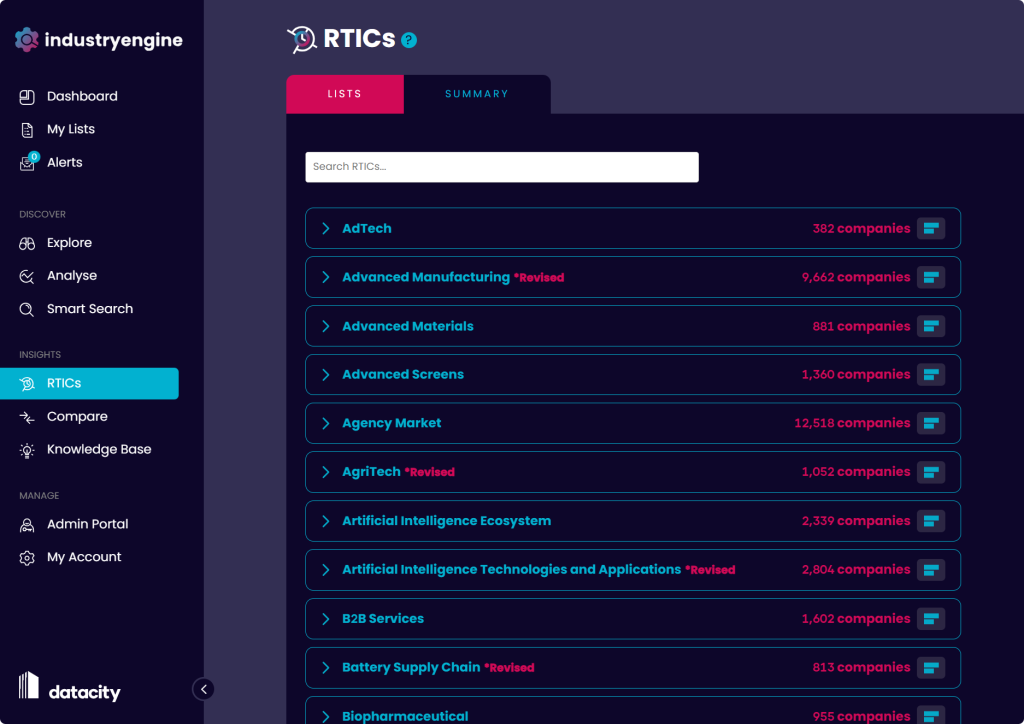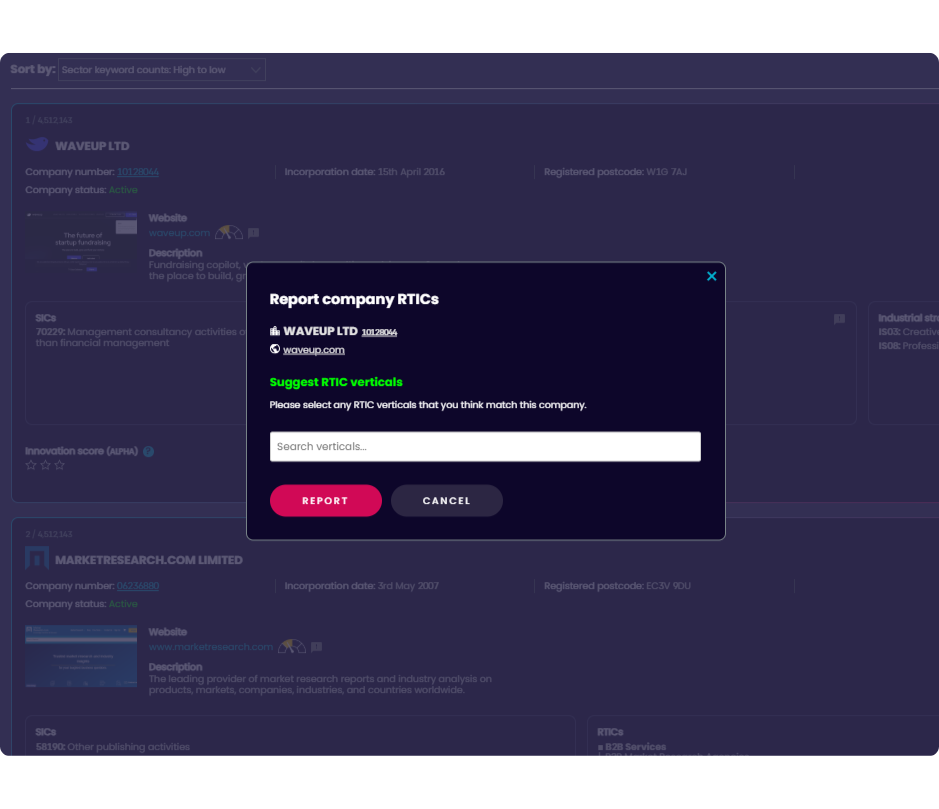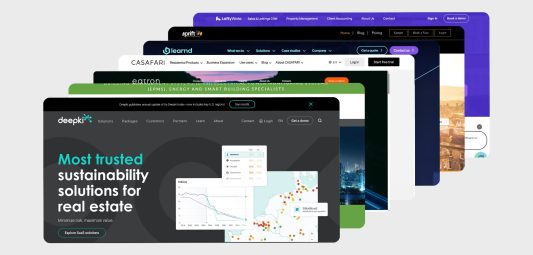Real-Time Industrial Classifications (RTICs) are The Data City’s proprietary form of industrial classification. Built using machine learning and based on how companies describe themselves online, RTICs offer a dynamic, real-world view of the economy as it actually functions, not how it looked over a decade ago.
RTICs evolve in two key ways: qualitatively, as sector language and terminology shift – think “natural language processing” moving to “LLM” and quantitatively, as companies enter, exit, or update their websites. Staying real-time means constantly updating and refining our data to reflect the most current activity in the economy.
In this article, we break down the different ways we keep RTICs up to date – covering our monthly maintenance updates, user-driven hot fixes, and deeper annual updates. We also explain how each process works, what gets reviewed, and how we ensure every RTIC remains accurate, high quality, and ready for action.

Types of RTIC updates
Our RTICs undergo three types of updates to ensure accuracy & relevance
- Maintenance update: This is a monthly automated update that ensures we continually classify new companies into RTICs where required.
- Annual update: This is an annual update focused on substantial changes such as changes in the taxonomy, updating the underlying training set & retraining the Machine Learning list.
- Hot fixes: This is a monthly fix to the RTIC that ensures we incorporate user feedback by adding companies reported for inclusion and removing any that have been incorrectly classified, keeping the RTIC accurate and up to date.
What is a maintenance update?
It is important that our RTICs provide the truest representation of a sector possible.
To achieve this, maintenance updates run monthly and ensure that we continually classify companies with matched websites into RTICs.
At present we account for:
- Companies newly incorporated with a matched website 6 months ago, allowing time for the site to develop so we can accurately assign an RTIC.
- Companies newly incorporated within the last 6 months with a manually matched website.
- Existing companies with updated or newly reported websites since the last maintenance update.
This process will be subject to further improvements and changes in the future.
Maintenance update process:
Monthly re-creation of classifiers: Every month, we re-create the existing RTIC classifiers using the original training sets and the websites/web text associated with companies as of the last Annual RTIC update or the RTIC creation date, if it was created less than 12 months ago.
Consistency with the last annual update: The existing classifiers are used to ensure that the same relevant terms and patterns identified during the last annual update or the initial creation of the RTIC for newer ones are consistently applied. This approach ensures that companies added during the monthly maintenance updates are classified using the same criteria as those already in the RTIC, maintaining a consistent definition across all updates.
Example:
- RTIC0052 Fintech was originally created on 16-09-2021.
- It was last annually updated on 09-10-2024.
- A maintenance update is scheduled for June 2025.
- The classifier used for this maintenance update was created in 2024, not 2025, to retain consistency in the classification applied to the existing and newly classified companies
Maintenance update QA
Maintenance updates also undergo a thorough QA process.
This is to check for the possibility of false positives and verify the % increase of company additions to an RTIC. A large % increase could indicate an issue with the underlying training set.
The following checks are performed:
- Manually verify that a company has been classified into the correct RTIC sector by checking its matched website.
- Manually verify that a company has been correctly classified into the correct RTIC vertical by checking its matched website.
Only companies that are correctly matched to both their sector and vertical are approved to be pushed live to the platform.
During the maintenance QA process the following data is logged;
- Total amount of companies considered
- Of which X were newly incorporated within the last 6 months
- Of which X were manually reported website matches
- How many unique companies were classified
- How many additions were classified in total to RTICs
- Of those additions how many were approved after QA for each RTIC
This information is logged and tracked internally to monitor changes to RTIC composition over time.
Annual update QA
Every year, our Real-Time Industrial Classifications (RTICs) undergo an annual update process. We prioritise updating RTICs based on how often they’re used on the platform and the date of their annual update.
Our annual update includes the following:
Review of the taxonomy
We revisit the Taxonomy of the verticals within the RTIC to make sure we capture the evolving nature of the sector. This may involve building new verticals or updating the existing verticals.
Reviewing/Updating the training set
We update our training set by replacing inactive companies with similar companies, removing those we can’t replace, and adding new companies that reflect current evolution of the sector
Lists rebuild & quality assurance
To improve the accuracy and relevance of the list after updating the training sets, we re-run the list and perform a thorough quality assurance check to catch any false positives. Additionally, we manually review a sample of 30 companies to ensure they align with the RTIC sector and vertical.
Updated RTICs
Once the update process is complete, we release the updated RTIC to our platform. Newly updated RTICs have “revised” labels on them, this then becomes the revised date for an RTIC.
How does a maintenance update differ from an annual update?
- Maintenance update: Focuses on applying existing classifiers to fresh company data.
- Annual update: Involves more substantial changes, including revising the taxonomy, retraining Machine Learning models, updating training sets, and adding new verticals if required.
What is a hot fix?
Users on the platform can report a company with a mismatched RTIC if they don’t have one.


These requests are reviewed monthly and pushed live on the platform. This way we incorporate user feedback into improving the quality of the RTIC.
Keeping RTICs accurate, evolving, and real-time
In this blog, we’ve broken down how we keep our Real-Time Industrial Classifications (RTICs) up to date, from monthly maintenance updates, annual updates and user-driven hot fixes. Each process plays a critical role in making sure RTICs stay accurate, relevant, and truly reflective of the sectors they represent.
By constantly evolving with new data, updated taxonomies, and feedback from our users, RTICs continue to offer a clearer, more modern view of the economy -one that traditional classification systems simply can’t keep up with.
Want to see the power of RTICs for yourself?
You can sign up for a free trial and explore the platform first-hand. If you’ve got questions or want to learn more about how The Data City can support your work, just get in touch with our team – we’re here to help.


